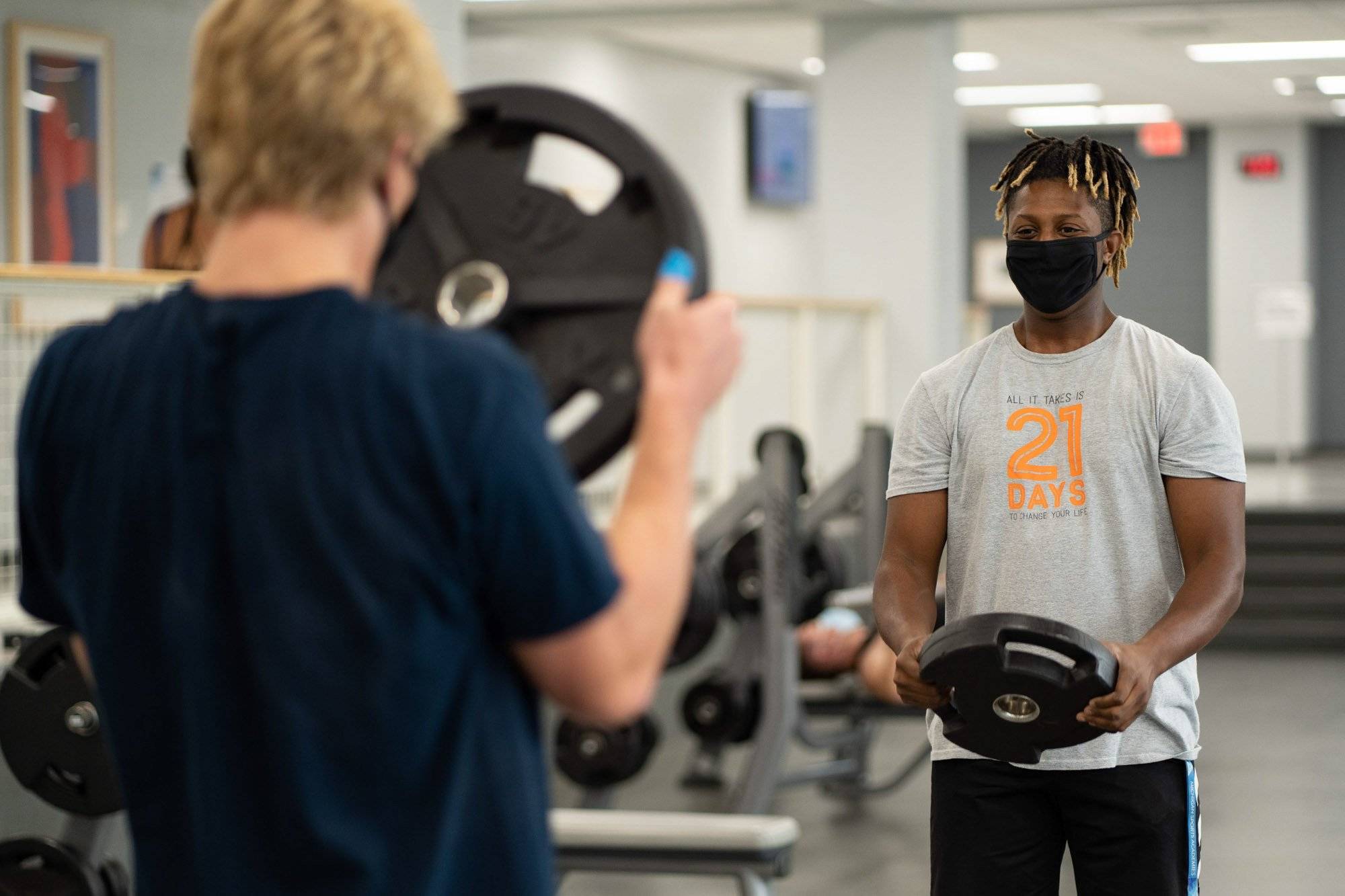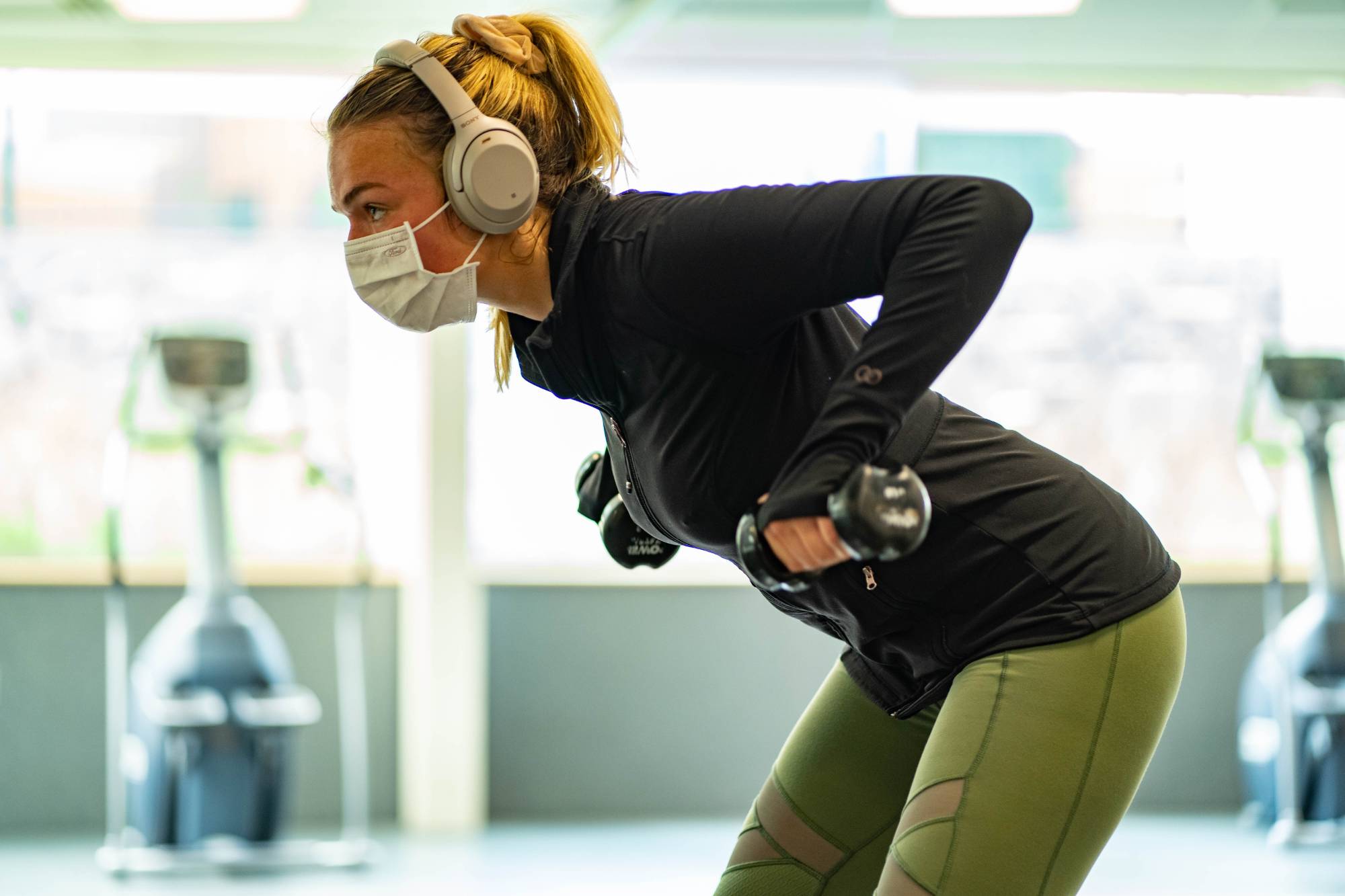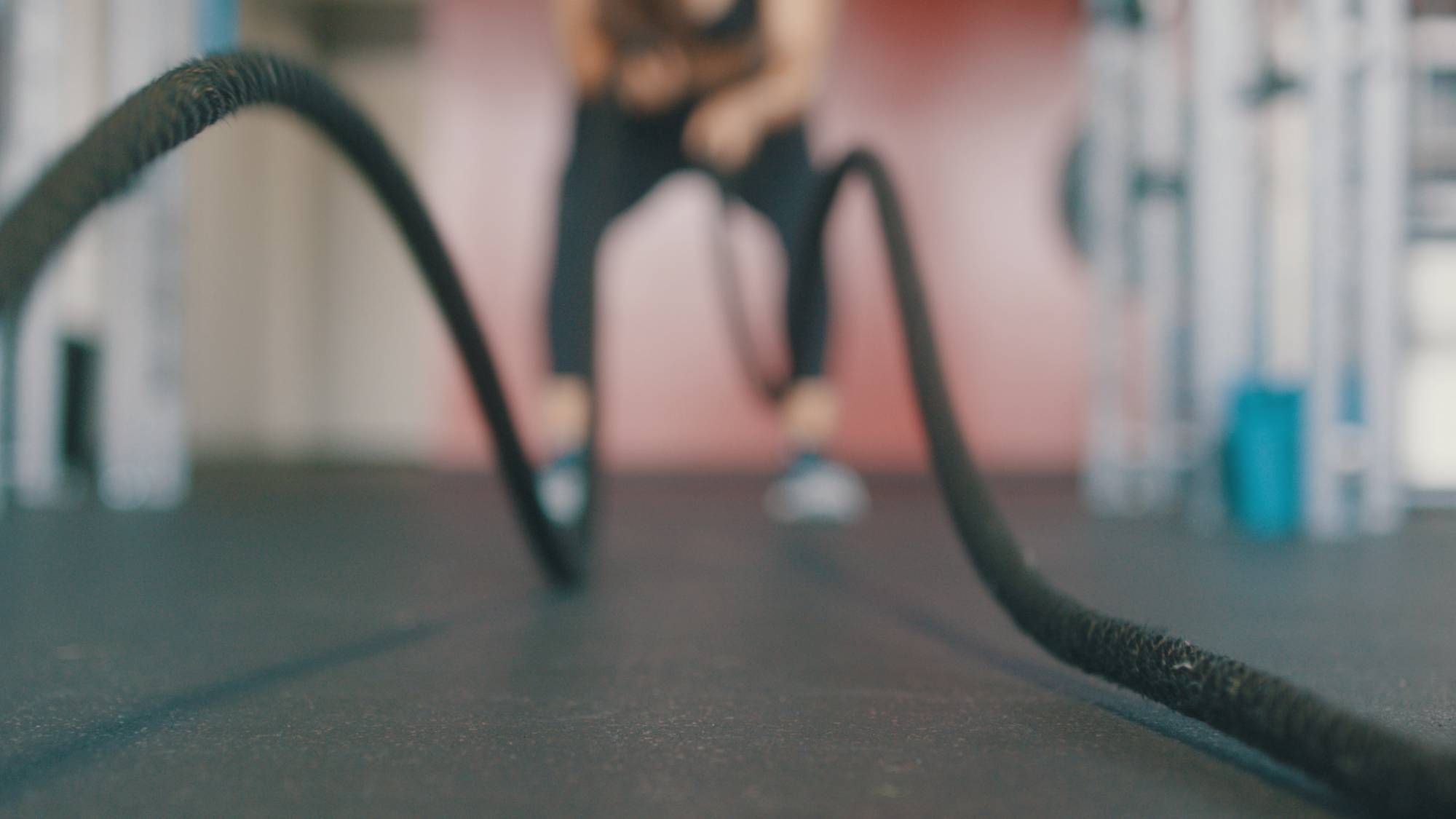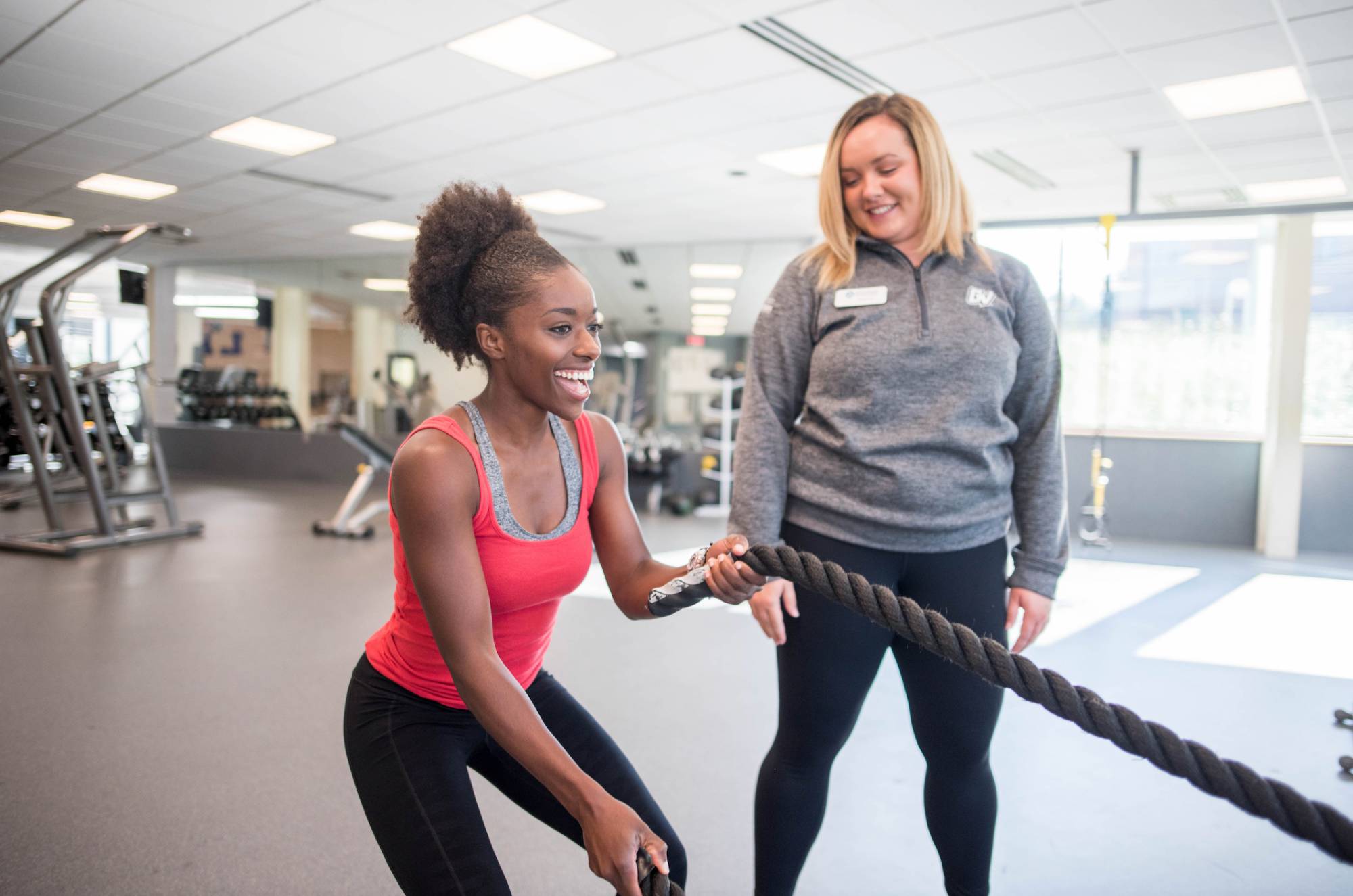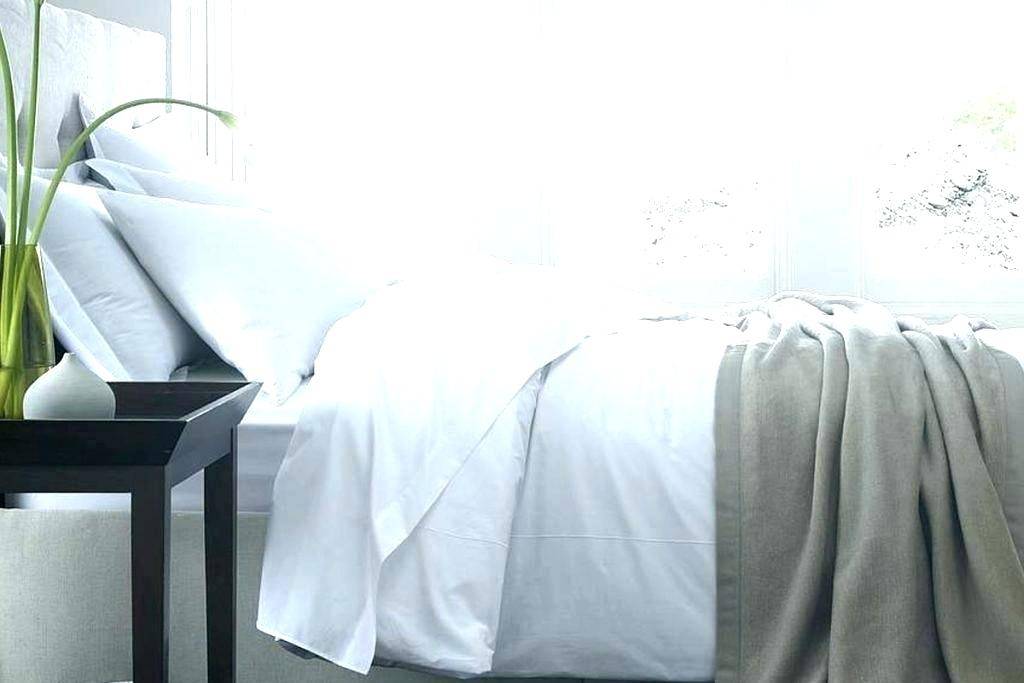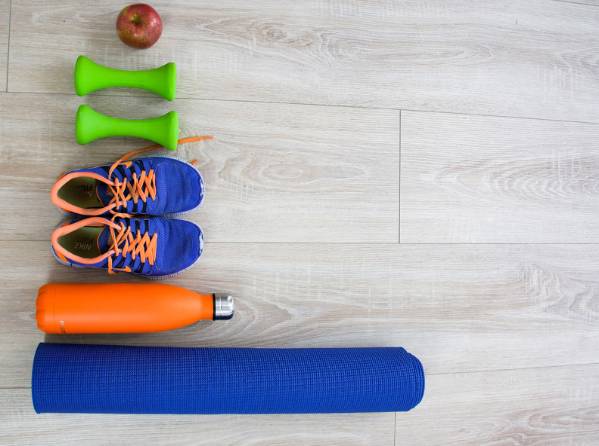Blog
Permanent link for Exercising with a Face Covering on November 2, 2020
The best face coverings for exercise should keep you safe, comfortable and dry, while being flexible enough to bend and move without falling off during your workout. Stay safe and comfortable while you break a sweat.
Why do I need to wear a face covering while exercising?
The Center
for Disease Control and Prevention (CDC) recommends wearing a
face covering as a simple barrier to help prevent respiratory droplets
from traveling into the air and onto other people when the person
wearing the face covering coughs, sneezes, talks, or raises their
voice. This is called source control. The use of face coverings is
even more important in an environment such as the Recreation Center,
where individuals increase their respiratory rate (heavier
breathing). The heavier an individual is breathing, the further their
respiratory droplets can potentially spread.
Is it safe to exercise with a face covering on?
Yes; it's safe to wear a face covering while exercising, but
considerations and precautions should be made. It’s recommended that
you perform low- to moderate-intensity exercise rather than vigorous
exercise while wearing a face covering. This is because of the
decreased airflow allowed through the face covering which is caused by
an increase in inhalation and exhalation resistance. This decrease in
air flow can make it more difficult to catch your breath and impact
your ability to properly regulate body temperature. A study published
in the International Journal of Environmental Research and Public
Health concluded that the increase in inhalation and exhalation
resistance has a very minor impact on the body’s physiological ability
to effectively achieve respiratory ventilation (less than 3% during
low to moderate physical activity). In other words, exercising with a
face covering is safe, though you may experience some slight discomfort.
Selecting and Wearing a Face Covering while Exercising
Look for face coverings with two or more layers that are made
from lightweight, moisture-wicking materials that will keep your face
dry and comfortable. Since you’ll be moving, select a face covering
that has a bit of stretch to it to ensure that it moves with you and
doesn’t slide down during your workout.
Your face covering should be comfortable and snug around your cheeks and nose, and large enough to cover your nose and mouth. Test and adjust the fit prior to exercising. If your face covering is uncomfortable, or makes breathing difficult prior to exercising, chances are it will continue to be uncomfortable and hard to breathe in during your workout.
Tips
- Check to ensure your face covering fits properly, covers your mouth and nose, and is secure so it doesn’t slide down or move during your workout.
- Take a moderated approach to exercise intensity. Face coverings may increase perceived effort and decrease performance during your workout.
- If you tend to sweat a lot when you exercise, bring an extra face covering with you to replace the damp one.
- If possible, have a few face coverings that you use specifically for exercise. This will help ensure you have a clean face covering available each time you plan to exercise.
- Be cautious and err on the side of caution. While exercising with a face covering, some may experience side effects including dizziness, light-headedness, and shortness of breath. If these symptoms occur, stop exercising.
- Change your mindset. Be grateful that the recreation center is open for you to utilize. Wearing a face covering is a small inconvenience compared to not being able to access the facility.
Lastly, wash your hands with soap and water, or use an alcohol-based hand sanitizer that contains at least 60% alcohol prior to putting on your face covering. Avoid touching your eyes, nose or mouth when removing your face covering, and wash your hands afterwards. While exercising, your face covering should be viewed as a barrier, and not an impenetrable shield. Therefore, continue to follow safe social-distancing practices, regular hand washing, and other sanitation measures, such as thoroughly wiping down equipment before and after use.
By: Becca Guilford and John Offerman
Considerations for Wearing Face Coverings:
- Slow the spread of COVID-19. (2020, August 7). National Center for Immunization and Respiratory Diseases (NCIRD), Division of Viral Diseases. Retrieved from https://www.cdc.gov/coronavirus/2019-ncov/prevent-getting-sick/cloth-face-cover-guidance.html
- Roberge, R. J., Kim, J.-H., & Benson, S. M. (2012). Absence of consequential changes in physiological, thermal and subjective responses from wearing a surgical mask. Respiratory Physiology & Neurobiology, 181, 29-35.
- Scheid, J. L., Lupien, S. P., Ford, G. S., & West, S. L. (2020). Commentary: physiological and psychological impact of face mask usage during the COVID-19 pandemic. International Journal of Environmental Research and Public Health, 17, 3-4.
Categories:
Fitness
General Wellness
Posted
on
Permanent link for Exercising with a Face Covering on November 2, 2020.
Permanent link for Exercising After COVID-19 on October 28, 2020
We are living in a new normal, a normal of face coverings and social distancing. Because COVID-19 is still so new to us, there are a lot of questions and uncertainty around the virus and its impact. It is, however, important to get back to some form of “normal” for your overall health. We can do this while adapting to the recommended Center for Disease Control (CDC) guidelines and keeping others safe.
How COVID-19 Effects Your Body
COVID-19 is a viral infection; the virus sticks to the small
hairs found in your nose and cells found in your mouth. Once the virus
has attached to the cells in your body, the active replication starts
almost immediately in the upper respiratory tract. 80% of people will
have mild symptoms such as a cough, fever, and loss of taste or smell.
Of that, 13.5% of people will have to be hospitalized due to shortness
of breath. Symptoms and signs of distress will appear in individuals
10 days after they contract the virus. After you contract the virus,
it is possible to get your lungs back to normal, but it will not be an
overnight fix. As a result of COVID-19, your lungs will begin to
develop scar tissue, which will take approximately six months to a
year to fully heal and get back to normal oxygen levels. After you
contract the virus and are symptom-free, you are able to get back to
daily activities, such as working out. However, you should consult
with your primary care provider on the best course of action for your
personal needs.
Before Starting Back Up with Exercise
Upon
arrival back into your fitness or exercise routine, make sure you are
limiting your alcohol and tobacco consumption, eating healthy meals,
trying not to skip meals, drinking plenty of water, and maintaining a
healthy sleep schedule to aid in your body’s healing process. Drinking
alcohol does not cure COVID-19, and the excess use of alcohol can
be harmful by increasing your health risks. Before you enter into
exercise, make a plan for modified exercises on your first day back.
Having more than one plan and being flexible is also important for
easing back into your routine. Some things to keep in mind:
- Breaking an intense 30-minute exercise into two 15-minute low to moderate sessions
- Modifying your workout
- Checking facility websites for updated cleaning, capacity guidelines, and any equipment restrictions
During Exercise
Once you are able to get back to exercise, avoid pushing yourself
too hard; your body needs time to heal. You should only be working at
about 50% of your usual intensity, and slowly ease your way back into
it. Make sure to stay hydrated when working out, and monitor any other
changes that your body may experience. Some individuals may feel
lightheadedness or dizziness when returning; try not to panic. Slow
down the workout and take a break to catch your breath. If symptoms
don’t subside, then, following CDC and facility guidelines, take your
face covering off to help maximize airflow. Try to avoid exercises
that are extra demanding of your cardiovascular system, like a HIIT
class, as it may be more difficult or cause more symptoms of
lightheadedness and dizziness. Finally, as always, keep up with CDC
guidelines to wash your hands regularly, stay six feet away from
others, and avoid face touching.
Staying active, whether it’s in the gym, outside, or at home, is beneficial to your health and wellness. Most forms of exercise can be performed almost anywhere. Especially now, it’s easy to find at-home workouts online. Whether you are someone who benefits from doing an at-home workout, going for a walk, run, bike ride, or hike, it’s important to keep moving and stay active. And don’t forget: stay hydrated, eat a healthy snack or meal, and do an active recovery cool-down to gradually lower your heart rate back to its resting state. If you go to the gym make sure to wash your hands with soap and water or use a hand sanitizer that is at least 60% alcohol, use your face covering, and maintain social distancing. Staying active and adapting a routine is one of the most important things you can do to help your overall health during this time.
By: Erin Colling
Resources:
- Exercising after COVID-19 Flyer
- GVSU Recreation & Wellness
- GVSU Alcohol & Other Drugs Services
- GVSU Campus Health Center
- GVSU Family Health Center
Sources:
- Reynolds, Colleen, et al. “How to Adapt Your Workout While Wearing a Mask.” OSF HealthCare Blog, 8 July 2020, www.osfhealthcare.org/blog/how-to-adapt-your-workout-while-wearing-a-mask/.
- “Should I Exercise with a Mask On?” Mercy Health Blog, 4 Sept. 2020, blog.mercy.com/coronavirus-covid-19-face-mask-while-exercising/.
- “What Are the Effects of COVID-19 on the Lungs?” Medical News Today, MediLexicon International, www.medicalnewstoday.com/articles/covid-19-what-happens-inside-the-body.
Categories:
Fitness
General Wellness
Posted
on
Permanent link for Exercising After COVID-19 on October 28, 2020.
Permanent link for Fueling Your Workout with Food on December 3, 2019
Deciding what to eat before a workout can be tricky. Eating too close to workouts or choosing the wrong foods may throw a wrench in your fitness routine. Add in a full day of classes, plus time for a healthy snack before being active, and it can sometimes seem almost impossible. Fortunately, we have some great tips on how to help you worry less about fueling up and focus more on your workout ahead:
Experiment with eating times.
- The truth is... there is no timeframe to eat before exercise that works for everyone’s body. Instead, find what works best for you within the timeframe of 30 minutes to 4 hours before beginning physical activities.
- Adjust portions accordingly to the amount of time you eat before your workout. For example, a snack would be a better option if eating 30-60 minutes before, and a meal is better for eating 1-4 hours before starting a workout.
Build a good snack.
- Carbs normally get a bad rep, but they’re a fantastic source of energy and are essential to any pre-workout snack. A good pre-exercise meal or snack will have carbs to help increase your energy and speed up recovery after.
- However, be sure to include some protein as well. This will help reduce soreness you may experience after your workout.
- Choosing foods that are low in fat and fiber will ensure tolerance to avoid an upset stomach.
Hydrate!
- Fun fact: our bodies are made up of approximately 2/3 water. This means that we not only need to drink an adequate amount everyday to promote better health, but especially when doing physical activities of any kind.
- Be sure to hydrate by consuming fluids, such as water or your favorite sports drink, an hour before working out.
- You can also hydrate by choosing foods mainly made up of water, such as watermelon, lettuce, and tomatoes. This will help to prevent dehydration that could end your workout early.
Have one of these tried and tested pre-workout combos.
Still a little hesitant on where to begin? Try a snack listed below that’s a good carb and protein combination to get your workout off to a great start:
1-4 hours before exercise:
- Lean hamburger or chicken on bun + side salad + yogurt or fruit parfait
- Low fat cottage cheese + crackers + grapes
- Oatmeal with brown sugar and walnuts + skim milk + banana
- Baked salmon + brown rice + roasted veggies
30-60 minutes before exercise:
- Apple or pear + nut butter
- Dried fruit + mixed nuts
- Jam sandwich
- Sports gel, bar, or gummies
Connect with our dietitian!
- Make an appointment with our Registered Dietitian for a personalized approach to your nutrition. Appointments can be made by contacting Fitness and Wellness Services at 616-331-3659 or rec@gvsu.edu.
- All packages include 3 appointments and are only $15 for students!
By: Alex Sixt
Categories:
Nutrition
Posted
on
Permanent link for Fueling Your Workout with Food on December 3, 2019.
Permanent link for Getting Involved with RecWell this Winter on November 11, 2019
It’s officially a new year - can you believe it?! With a new semester comes adjusting to a new schedule. It can be difficult to plan exercise and healthy habits while simultaneously mapping out classes, but it’s important to start creating healthy habits early on. Get a head start on improving your wellness by getting involved with Recreation & Wellness and attending some of these upcoming events:
TREK100
- Looking for a challenge to start of your year? Look no further! TREK 100 encourages participants to complete 100 miles in 9 weeks (challenge is from Jan 1 to Feb 28, right before Spring Break)!
- There’s a variety of ways to get your miles - running, walking, taking a Group Ex class, playing IM Sports, using equipment in the Rec Center, or really any other way you like to get moving.
- You get access to an online dashboard to log and keep track of all your miles for you!
- Need more motivation? Our leaderboard shows where you rank among all participants, and we’ll be giving away free swag at certain mileage milestones!
- Register here to begin your TREK on January 1!
Outdoor Adventures Trips
- Get “OA” (get it?? Get away…) from campus and into nature! Trips are a great way to enjoy the great outdoors with other GVSU students, explore, and make new memories!
- Take a trip with us to Michigan IceFest to try ice climbing in Northern Michigan or
- Travel to Moab, Utah for Spring Break and choose between two adventures: hiking or climbing.
- Each trip has specific information about transportation, what to bring, and how much it costs.
- Check out a complete list of OA events on our website for more information on how to join the adventures!
Massage Services
- Feeling a little tense lately? Schedule an appointment with our massage therapist! A massage is the perfect way to unwind and relax.
- Our massage therapist is trained in Swedish, relaxation, deep tissue, and sports massages to help get your body feeling better.
- Schedule an appointment at 616-331-3659 or rec@gvsu.edu.
Get “Unplugged”
- As a student, chances are that you spend a lot of time looking at a screen; it’s where we get most of our information! Fortunately, RecWell has the perfect excuse for you to take a break!
- From February 23-29, we’ll be “unplugging” with a variety of activities that will help you disconnect from technology (and social media, or whatever that means to you). Plus, these opportunities allow you to connect more with others and maybe even meet new people!
- There are so many ways to get involved this week, we can’t list them all - so check them out at gvsu.edu/rec/unplug Or, tell us why you unplug and how Rec&Well programs help you take a break from technology!
8 Dimensions of Wellness
- Check out the 8 Dimensions of Wellness to help you navigate and prioritize your wellness this winter.
- Take an inventory of your wellness with this short quiz.
- Check out our wellbeing guide for tips on promoting wellness on campus.
Intramural Sports
- Registration will open on January 1, but check out all of the IM Sport schedules now!
Get a fresh start in 2020 by establishing healthy habits that can carry you into the next one! For more ideas on how to get involved with Recreation and Wellness, visit our website.
By: Alex Sixt
Categories:
General Recreation
Posted
on
Permanent link for Getting Involved with RecWell this Winter on November 11, 2019.
Permanent link for Nutrition Tips on October 14, 2019
With busy schedules and a few too many trips to late night, you might find your diet slipping when it comes to getting the nutrition that you need. Eating healthy on a budget, in a small kitchen in your apartment, and with a full day of classes isn’t always the most convenient. Some our our our favorite tips for making nutrition a habit and a lot more accessible are:
-
Water, Water, Water. Yes, you’ve heard it time and
time again. Drinking an adequate amount of water every day can have
substantial effects on your health. Staying hydrated promotes better
productivity,
mood, and optimal body function. Stray away from drinking too
many liquid calories, such as sodas and juices, that have a lot of
hidden sugars. If you’re looking to shift your current habits, keep
liquid calories as a treat. We suggest bringing a water bottle to
class to make drinking water convenient and more accessible.
-
Try meal prepping! If you have a full schedule and
are often too tired to cook when you get home, plan for the week
ahead. Instead of feeling tired and hitting the drive thru, have
something ready to warm up when you walk in the door. Meal prepping
will save you money, time and make healthy eating less stressful.
Whether overnight oats for busy mornings or just making 4 servings
when cooking dinner instead of one, your busy self will thank you
for planning ahead. (Pinterest
has plenty of ideas to switch up your meals from week to week!)
-
Read your labels. This doesn’t mean you have to
switch up your current eating habits; you should just be more aware
of the things that you’re putting into your body. Oftentimes the
sugar, saturated fats, and calorie count can be misleading if you
aren’t accounting for the serving size. Sometimes a simple swap can
offer much more of the things you want, like nutrients, and less of
the things you don’t want, like sugar. Apps like My Fitness Pal also
provide an easy way to track your nutrients by simply searching for
the food that you’re eating!
-
Keep healthy options readily available. If you get
a sudden craving for something before bed, keeping healthy sweets
like fruit at hand will help curb those unhealthy cravings. If you
don’t have unhealthy options at easy access, you won’t eat them.
Plan out healthy snacks to bring to class and for times like late
night cravings. We suggest things like nuts and fruit. Or if you
really are craving the unhealthy snacks, buy those in portion
controlled containers. Buying those snacks in bulk sizes can lead to
you eating more than needed.
- Visit our dietician! For a more individualized approach to your nutrition, make an appointment with our Registered Dietitian right here on campus. Appointments can address concerns ranging from how to eat healthy on campus, as well as how to adopt healthy eating behaviors and concerns like eating disorders and dietary restrictions.
For more information about nutrition:
- check out our tip sheets about grocery shopping tips, simple food swaps, and fighting the “freshman 15”,
- call us at (616) 331-1732 to connect with our dietitian,
- or visit the Recreation and Wellness website.
By: Alexis Smith
Categories:
Nutrition
Posted
on
Permanent link for Nutrition Tips on October 14, 2019.
Permanent link for Positive Mindset on October 9, 2019
How does the word “fitness” make you feel? Does it excite you or leave you feeling dread? Your outlook on your healthy routine is influential on your success for maintaining it. Of course, if you truly love to workout and love to incorporate good nutrition in your diet, it will make it much easier to be successful. But, what if you don’t love it? How do you change your attitude toward living a healthy lifestyle?
-
Stop viewing good nutrition and fitness as
restrictions. If you completely cut out lazy days and foods
that you love, you’ll be less likely to maintain that routine. Have
you ever completely lost your motivation? Sometimes by making your
lifestyle too strict, it can feel more like a punishment rather than
doing it to better yourself. Change your mindset by creating a
balance. Eat small portions of less nutritious foods, find recipes
that make eating healthy fun, and don’t feel guilty about spending a
day being lazy. It should be about creating a healthy
lifestyle, not creating a boot camp for your
well-being.
-
Find the parts of living healthy that you look forward
to. Realistically, there isn’t just one way to exercise. If
you don’t like the treadmill, don’t go on the treadmill. If you
don’t like going to the gym, you don’t have to go to the gym!
Fitness isn’t the same for everyone, and it shouldn’t feel like it
has one definition. If you love group exercise or going for a run
outside or rock climbing or hiking, do that instead! If you love
working out with friends, find a dedicated workout partner! Be
conscious of what you do that makes you excited to keep going.
-
Make sure that you’re doing it for the right
reasons. If fitness to you is looking at the scale every
night and leaves you with negative feelings, you’re creating a
negative relationship between you and living healthy. Focus less on
how exercise is making you look and more on how it is making you
feel. How do you feel after completing a successful workout? How
much more energy do you have when have a day full of eating
nutritious meals? If things like counting calories has you feeling
consumed or leaves you feeling dread, then simply don’t do it. Think
of all the other benefits that come from exercise and make that your
reason for continuing.
-
Take a step back every once in awhile. It’s
important to reflect on your journey, and this doesn’t always mean
focusing on your end goal. It’s important to recognize your
progress, to see how far you’ve come, and to be proud of yourself!
If you have a constant focus on how far you are from your goals, you
won’t be motivated to achieve them. Recognize small successes -
whether it is being able to do more reps, or choosing an apple over
a muffin. Your self-confidence is important, and oftentimes, you are
making more progress than you recognize. Pat yourself on the back
when it’s well deserved.
- Remember that a healthy lifestyle is flexible, because life isn’t consistent. Let’s face it, some days or even months are more difficult than others. Your attitude shouldn’t be that you need to get a full workout in or the day is wasted. Some days, maybe taking a walk around the neighborhood is all you have the time and energy for, and that’s OKAY! You shouldn’t have the feeling of guilt if you eat pizza with friends, or if you can't complete your workout for that day. Creating a healthy lifestyle is balancing what is good for you with what makes you happy. Choose healthy habits the majority of the time, but don’t hold yourself back from the joys of life.
Your definition of fitness is going to be completely different than anyone else’s, and that’s encouraged! We’re all different, and that’s what makes it so great. Go to dinner with friends, be lazy when you feel like it, and don’t feel like living healthy is a chore. Start each day with the mindset that you’re doing this to better yourself and your pace is the perfect pace.
By: Alexis Smith
Categories:
General Wellness
Posted
on
Permanent link for Positive Mindset on October 9, 2019.
Permanent link for What is wellness? on September 26, 2019
Being a student can be challenging to navigate and a little confusing. Life can get busy, and it might feel like you have no time to focus on yourself. That’s understandable, and you’re not alone. Knowing that and caring about your individual well-being and your experience as a student, it’s important to take time to prioritize yourself and your well-being.
What exactly is wellness?
Wellness is a life-long journey; "a conscious,
self-directed, and evolving process of achieving full potential"
(National
Wellness Institute). According to the World Health Organization, wellness
is “a state of complete physical, mental, and social well-being, and
not merely the absence of disease or illness.” This doesn’t mean just
going to the doctor when you’re feeling sick, it’s about evaluating
all aspects of how you feel. As a college student, it is especially
important to take care of yourself. Many of the habits you form in
college may stick with you, so it’s important to build healthy habits
now. Understanding the 8 dimensions of wellness can help guide your
personal well-being during your college experience.
Emotional Wellness
Emotional wellness involves enjoying your life and adjusting to
changes adequately. It is important to evaluate your emotional
wellness to ensure you are aware of your feelings and are delegating
them as needed. This includes: expressing your feelings to others,
seeking support in times of need and consciously evaluating yourself
to improve. A good way to assess your emotional wellness is by
evaluating how you treat others, feeling as if your life has meaning,
and just simply liking who you are. For more tips for improving your
emotional wellness, visit the University Counseling Center.
Social Wellness
Social wellness is important in creating a sense of belonging and
upholding a strong support system. Coming into college can sometimes
feel lonely, and it’s important to get involved and work to develop
that sense of belonging. Relationships with your family, friends, and
peers is important when assessing your support system. Are you
balancing your social and personal time? Is your social circle a
positive influence to you? These are examples of good questions
to ask yourself when evaluating your social wellness. Find more ways
to get involved and expand your social group by visiting Recreation & Wellness or the
Office of Student Life.
Occupational Wellness
College itself is a tool toward your journey to occupational wellness. Although, it’s important to stay in touch with yourself to explore different opportunities for careers that are right for you. Are you pursuing a career that supports the life you are trying to create? Are you excited about learning in the classroom? Don’t be afraid to look into things you’re passionate about, and don’t be afraid to ask for support. Visit the Career Center or Academic Advising Center for career advice and academic support.
Intellectual Wellness
Intellectual wellness involves your formal education in the
classroom but also includes all learning outside including your
hobbies and other interests. Are you challenging your brain on a
regular basis? Make an effort to pursue new things and keep
yourself on your toes. Examples of ways to maintain your intellectual
wellness journey include: reading, student organizations, attending
new events, and many more.
Financial Wellness
Financial wellness is important to students being that they
understand their financial situation and resources. Topics in this
dimension include: income, savings, budgeting, etc. Do you feel
like you have a good understanding on how to budget and handle your
finances? Learn more about money management and even your
journey from college to a career, visit MoneySmart Lakers.
Environmental Wellness
Environmental wellness encompasses both feeling safe in your
environment and also spending time at places that support your
well-being. Be conscious of the experiences that you enjoy and
surround yourself with those who make you happy. If you are concerned
about your safety, visit the Department of Public Safety or
learn more about how you can impact the environment through the Office of Sustainability Practices.
Spiritual Wellness
Spiritual wellness involves the time spent focusing on your sense
of meaning in life. It is important to feel purpose in life and to
uphold a strong connection to yourself. Do you feel like you’re
living on autopilot? Focus on the values and beliefs that are
important to you and surround yourself with a community that shares
those same principles. It is important to feel as if your life has
meaning. Get connected through Campus
Interfaith Resources.
Physical Wellness
Physical wellness focuses on having a healthy body by practicing
good habits. It’s important that we take care of our bodies and make
sure we’re hydrated, eat nutritious foods, exercise regularly and get
enough sleep. Also, make sure you’re getting regular check-ups with
your physician. If you are concerned with your physical health, the Campus Health Center
provides care for GVSU students, and Recreation & Wellness offers
something for everyone and a multitude of ways to get involved, be
active, and live healthy!
Recreation & Wellness has recently changed its name from Campus Recreation, and is dedicated to supporting student well-being and toward connecting students with the resources they need. Visit the Student Wellness website or contact rec@gvsu.edu for more information.
By: Alexis Smith
Categories:
General Wellness
Posted
on
Permanent link for What is wellness? on September 26, 2019.
Permanent link for What's UFit, again? on July 16, 2019
So, you have fitness and wellness goals, but how do you know you’re on track to achieve them? Or, maybe you don’t even know where to start. Sometimes the pathway to your fitness goals isn’t very straightforward. We get it; we know you have a lot going on and you may not be an expert. Luckily, our UFit Plan provides you with a one-on-one consultation with a fitness specialist to discuss your wellness goals, current health, fitness, nutrition, and lifestyle status. And the best part? It’s FREE for students! Basically, it’s free personal training!
If you’re having a hard time maintaining an active lifestyle, consulting with our fitness specialists can make your goals more achievable. In your first appointment, you will discuss your goals, fitness preferences, and schedule. A plan is being created for you, and only you, so everything will be considered to make this plan manageable for creating life-long habits. Additionally, a break down will be provided outlining the importance of how nutrition, stress management, and activity levels play in your overall wellness. We’ll also give you helpful suggestions in managing them.
You will complete a fitness assessment in that first appointment to evaluate your current status of endurance, strength, body composition, flexibility, and other benchmarks around achieving your established goals. These benchmarks will be recorded so that you can track your progress as you move through your fitness journey.
“I chose to participate in the UFit plan because I liked the idea of meeting with someone to talk about my goals and help make a plan for my personal fitness goals,” said Sofia Draper, GVSU Student. “It was amazing to sit and talk about my health with someone who knew how to answer the questions I had and debunk some of the myths I had heard.”
After your first meeting, you will receive a personalized plan to follow until your second appointment. After working through your routine, you have the option to complete a prescription appointment. This appointment will involve establishing a reasoning behind the exercises and mobility techniques that have been personalized to you. The plan is designed for you specifically, and our fitness specialists are committed to ensuring that you understand the purpose of the plan and are comfortable with what it entails. Additionally, an equipment orientation will be provided in this appointment to evaluate all of the equipment in the Rec Center and learn how to get set up on each machine.
From there, an additional appointment will be scheduled weeks following the prescription appointment to evaluate how the plan worked with your fitness specialist. From there, the plan can be evaluated by both the fitness specialist and the client with room to reevaluate the current plan and make any changes if needed. You may also complete another round of fitness testing to track your progress from your initial appointment.
“Getting started with the UFit plan during my freshman year at GV helped me to take control of my personal health and fitness,” said Emma Merlington, GVSU Student. “It gave me personalized options for working out and helped motivate me to schedule in time for the gym.”
As mentioned, UFit is FREE for GVSU students, but also available to non-students for $25. To get started, contact the Fitness and Wellness Services offices at 331-3659 or rec@gvsu.edu.
By: Alexis Smith
Categories:
Fitness
Posted
on
Permanent link for What's UFit, again? on July 16, 2019.
Permanent link for The Scoop on Sleep on July 16, 2019
It comes as no surprise that getting a good night’s sleep can lead to a better quality of life. Although, more often than not, college students admit to be lacking in their quality of sleep… let’s not even talk about finals week. If you find yourself relying on all-nighters, we have some news for you. College students who pull the occasional “all-nighter” are actually more likely to have a lower GPA. Sleep is essential to achieving higher grades.
If your energy levels are lacking or you feel like you aren’t at your peak performance, lack of sleep could the reason. Feeling less alert is often caused by your weekly sleeping habits. Specifically, this could be how you “make up” for your lack of sleep. The American Academy of Sleep Medicine even advises those who stay up late during the week and “make up” for their lack of sleep by sleeping in over the weekend that they are actually doing more damage. Sleeping in late on the weekends, which a lot of people do, sets off your internal body clock. This begins to damage your sleep habits when trying to wake up for morning classes again the next week.
Even so, putting off sleep throughout the week can cause adverse effects the longer that you do so. In a recent study, “every additional day per week that students experience sleep problems, their cumulative GPA lowered by 0.02.” In addition, the likelihood of the student dropping a course increased an average of 10% every day.
On top of lack of energy and affecting your GPA, not getting enough sleep can weaken your immune system. As a student, attendance is essential to academic success. Becoming more susceptible to a cold, or even the flu, can take a toll on your body (and your attendance). By getting enough sleep, your immune system will keep performing as it should and leave you less exposed to sickness.
So, what does this all mean?
Sleep is extremely important, and it isn’t something you can just
“make up” for, either.. In fact, college students (18-25 year olds)
are recommended to get 7-9
hours of sleep a night.
Now, what can you do to promote better sleep and productivity?
-
Make a habit of going to bed early. This means turning your mind off about 30 minutes before bed by stopping homework, turning off the TV, and putting down your phone for the night.
- Only sleep in your bed. Watch TV, read, and do homework from the couch. Keep your bed just as a safe haven for sleep.
-
Set an alarm for when it’s time to go to bed. That’s right; you should remind yourself when it’s time to unwind. Set a daily alarm so you don’t get stuck studying and realize it’s already 2am.
-
Stay consistent on the weekends. It’s okay to sleep in an extra hour if you’re looking to catch up on sleep, but don’t allow yourself to sleep through your entire day and completely set off your internal clock.
-
Eat a light snack before bed. Don’t overeat or allow yourself to go to bed hungry, as both can cause you to toss and turn at night. Balance it with a light snack if needed.
By: Alexis Smith
Categories:
Sleep
Posted
on
Permanent link for The Scoop on Sleep on July 16, 2019.
Permanent link for The Importance of Rest Days on July 9, 2019
If you hear “rest day” and visualize a day spent watching Netflix with a carton of ice cream, there may be some confusion about what a rest day really is. Rest days are built on misunderstanding whether it is perceived as being lazy, or that they consist of completely sedentary activity. Whether you don’t currently incorporate rest days in your routine, or if you might have the wrong idea about what they are, rest days should be considered a regular addition to your workout week.
There is a lot of value in balancing workouts with designated rest. Although, rest days are not to be confused with “cheat days.” Cheat days allow you to give yourself a break when it comes to your diet. Rest days allow your body to recover by taking time off from training, which is strictly related to your physical activity. Either way, both can provide similar benefits, such as an increase in motivation and well deserved mental breaks.
While it may feel like a waste of time to give your muscles a break, rest days are key to forward progress. Your body is actually doing a lot of work on those days, and it leads to an extreme pay off. While you take a mental relaxation from training, your body is working hard to regain your energy and generate new muscle tissue. If your goal is to become stronger, you need rest days.
What are other benefits, you ask? Rest days reduce the risk of injury, improve your sleep, and can even increase your motivation level. If you’ve recently started an exercise routine, it’s easy to get excited and cram too many workouts into one week. While high motivation is good, it may cause you to overwork and can eventually cause you to lose focus. Incorporating rest days into your routine gives you a chance to change it up and get excited about returning to your normal exercise schedule. Your routine should never feel like a chore. If you’re exerting too many hours into your week, you might push yourself to a plateau of motivation.
Although, don’t get too excited. This doesn’t go to say that your rest days have to be, or should be, filled with sedentary activity. While a day spent in bed might sound enticing, active rest days are the perfect balance. Active rest days can provide enough rest and relaxation for your mind and muscles, but also won’t set you back enough to a lack of motivation or leave you feeling stiff when you hop back into your routine. Need suggestions? Take a light walk, go swimming in the lake, play frisbee with a friend, or do anything that keeps you moving just a little.Your rest days shouldn’t feel forced; fill them with activities you look forward to.
If your goal is to transform fitness into a lifelong habit, there will most likely be days where you just can’t find the time, or you just need a day to mentally unwind. Don’t feel guilty about scheduling your rest days. It is important to slow down and allow your body to recover so you can move further toward your goals in the long run. Be kind to yourself and recognize your perfect balance.
By: Alexis Smith
Categories:
Fitness
Posted
on
Permanent link for The Importance of Rest Days on July 9, 2019.

